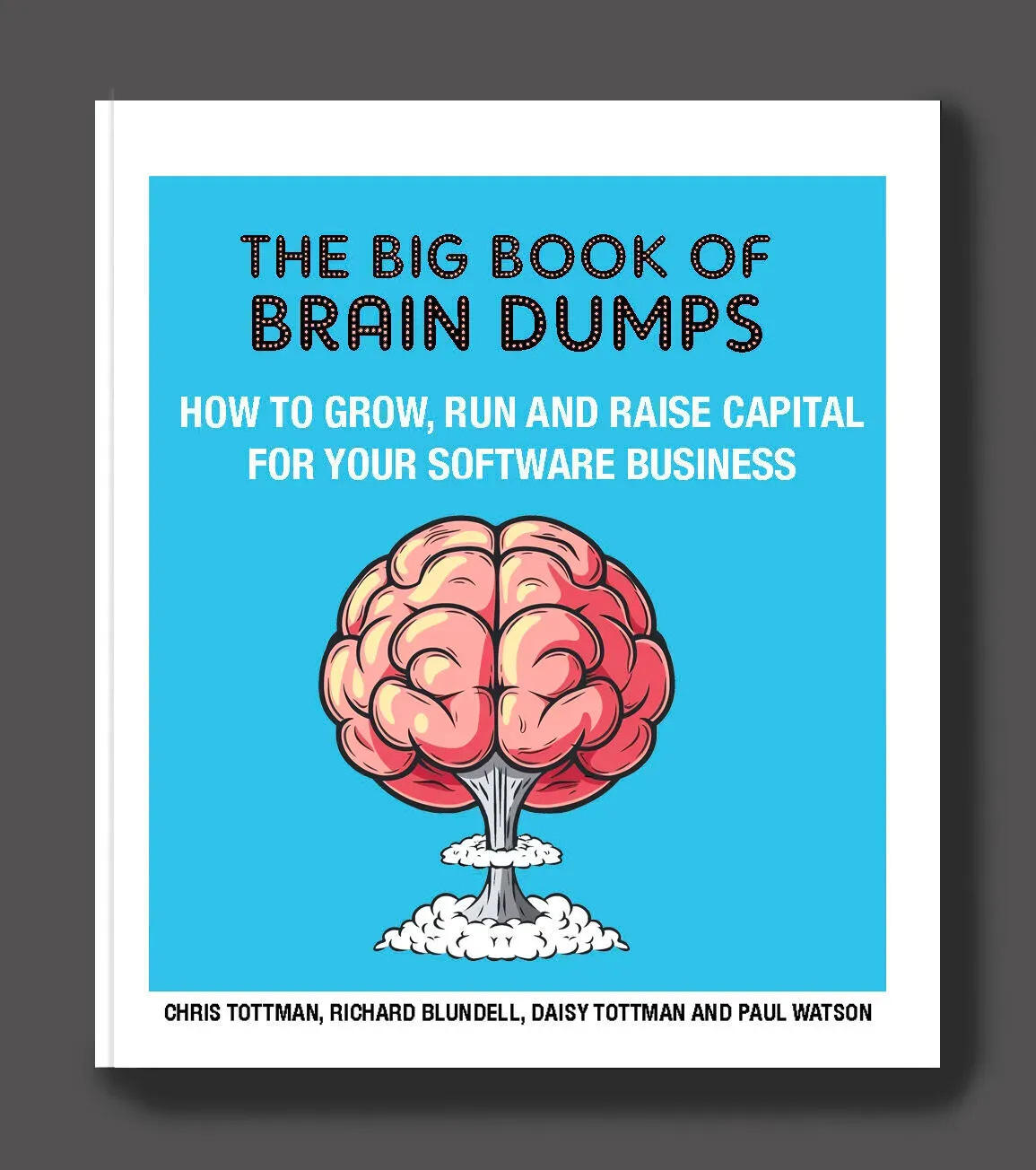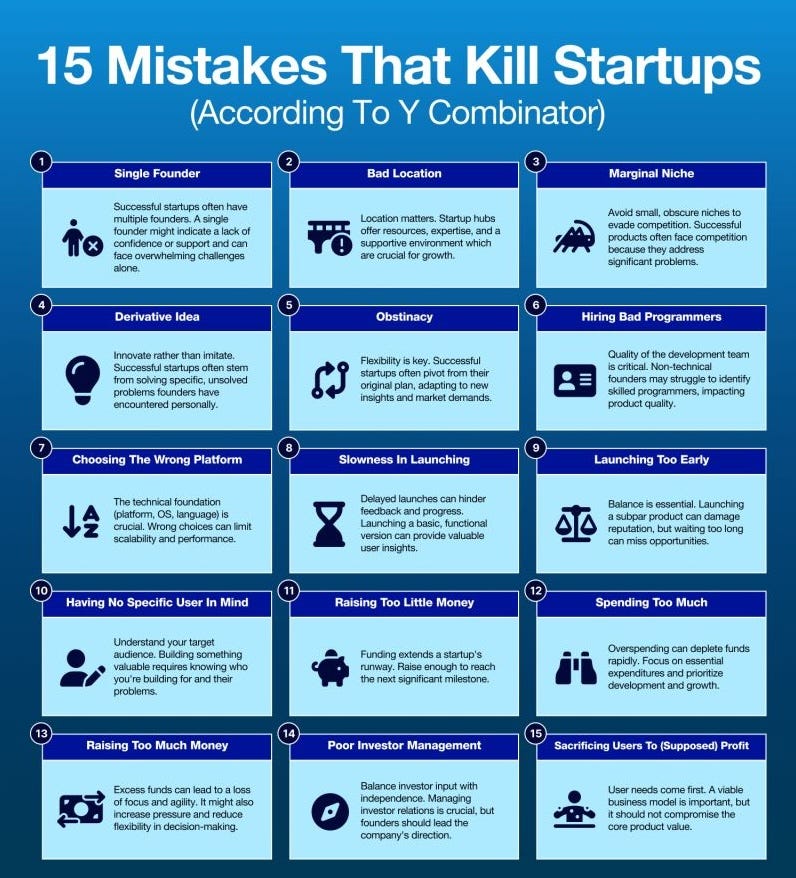🚫 15 Mistakes That Kill Startups—and How to Avoid Them
The startup graveyard is full of founders that didn't make it past year one—not because they weren’t talented, visionary, or ambitious—but because they made predictable, preventable mistakes.
👋 Hey, Chris here! Welcome to BrainDumps—a weekly series from The Founders Corner. If you’ve been reading along, you know this series is a preview of a bigger project. Well, it’s finally here: The Big Book of BrainDumps is out now!
It isn’t a theory book—it’s the founder’s field manual. Inside, you’ll find 70 powerful frameworks distilled from 30+ years scaling software companies to hundreds of millions in ARR, 20+ years investing in 500+ B2B tech startups, and over $1B of shareholder value created. From raising capital to hiring your first VP of Sales, this book turns scars and successes into practical playbooks you’ll return to again and again. I expect most copies will become well-worn, scribbled on, and dog-eared—because it works.
At Notion, we’ve got a saying:
“We want our founders to die solving problems no one has ever solved before—not from problems that have been solved many times over.”
I’ve repeated that line so many times in board meetings, pitch calls, and mentoring sessions that I’ve lost count. Because sadly, it’s not the bleeding-edge technical problems or the bold market swings that take most startups down. It’s the basics. It’s the stuff every founder thinks they’re too smart to mess up.
This article isn’t here to scare you. It’s here to help you survive. It’s based on a now-famous list from Y Combinator titled “15 Mistakes That Kill Startups”—but I want to go deeper. I’ve seen every one of these mistakes happen in real life. Some, I’ve made myself.
Let’s dig in. Think of this as your early-stage radar. The goal? Stay alive long enough to solve the problems only you can solve.
🧠 The Founding Team: Where It All Starts
1. Single Founder
Going it alone? You’re choosing the hard road.
I once backed a solo founder with extraordinary talent. His vision was crystal clear. But when things started to wobble—product delays, customer churn, doubts—he had no one to absorb the shock, no one to push back. Eventually, he burned out.
Lesson: Co-founders aren’t optional—they’re your first line of resilience.
2. Bad Location
Your environment can kill your momentum.
We had a promising B2B startup based in a sleepy corner of Europe. Brilliant product, terrible access to capital and talent. The day they moved to London, everything accelerated: hires, intros, press, credibility. Geography still matters more than people think.
Lesson: Put yourself where the action is. Ecosystems compound growth.
3. Marginal Niche
A perfect solution for a tiny market is still a dead end.
I once saw a team spend two years building for a vertical so niche that even if they dominated it, they wouldn’t hit £1M ARR. Great execution, zero upside.
Lesson: Niche is fine—just make sure it scales.
💡 The Idea and Execution Trap
4. Derivative Idea
Copy-paste startups rarely win.
"Uber for X" and "Slack for Y" have flooded investor inboxes for years. But what’s always missing is originality. I ask:
“Why you? Why now?”
And too often, the answer is... silence.
Lesson: Solve a problem you understand. Not one that just looks good on a slide.
5. Obstinacy
Stubbornness isn’t strategy.
We backed a brilliant team who stuck to their original GTM model far too long. The market was shouting “Pivot!” but they weren’t listening. A competitor launched a simpler approach and ate their lunch.
Lesson: Be relentless about your mission, flexible about your methods.
6. Hiring Bad Programmers
Cheap code is expensive.
I’ve seen startups lose 9 months to outsourced tech that barely held together.
“We’ll refactor it later.”
This lie becomes your death sentence.
Lesson: Invest in quality engineers. Your product is only as good as the people building it.
🧱 Platform, Product, and Timing
7. Choosing the Wrong Platform
Your foundation needs to serve the long game.
A health-tech startup I advised built on a trendy new stack—only to find out no enterprise IT team would touch it. Rebuilding cost them a year and most of their budget.
Lesson: Build with scale in mind. Ask: “Will this still work when we 10x?”
8. Slowness in Launching
"Stealth mode" is often just fear dressed up as strategy.
One founding team I mentored spent 14 months perfecting their first version. Meanwhile, a competitor launched fast, iterated quickly, and owned the market.
Lesson: Speed wins. Launch fast. Learn faster.
9. Launching Too Early
But don’t launch trash.
Another startup raced to ship for a big PR moment—except the product barely worked. It bombed on Product Hunt, and worse, lost the trust of early champions. The reputational damage? Permanent.
Lesson: MVP ≠ half-baked. It must deliver real value to real users.
🎯 Understanding Your Market
10. Having No Specific User in Mind
Startups for “everyone” help no one.
I once saw a SaaS team with a homepage that promised “productivity for teams of all sizes.” No one knew who it was for. Once they narrowed their ICP to "remote-first product teams in fintech," growth clicked.
Lesson: Know your customer like you know your best friend.
11. Raising Too Little Money
Starving the machine doesn’t make it efficient—it just makes it slow.
One founder I coached raised just enough to survive 9 months. He needed 12 to hit traction. He ran out of cash right before the breakthrough. Heartbreaking.
Lesson: Raise for the journey, not just the next three sprints.
12. Spending Too Much
You can burn through £3M and have nothing to show for it.
We backed a startup that hired like a Series C company at seed stage. Gorgeous office, top-tier hires... no revenue. When the market tightened, they folded fast.
Lesson: Spend like you’re bootstrapped—even when you’re not.
💸 Managing Money and People
13. Raising Too Much Money
Easy capital is dangerous.
I’ve watched founders raise oversized rounds and lose their urgency. The burn goes up, the experiments get bloated, and the clarity fades. Big war chest, but no real plan.
Lesson: Money doesn’t make you smart. Discipline does.
14. Poor Investor Management
Silence is deadly.
A founder once ghosted their cap table for three quarters. When they hit a wall, they had no goodwill left. Contrast that with founders who send monthly updates—even when it’s bad news. Those are the ones who get support when it counts.
Lesson: Your investors are partners. Keep them informed. Involve them early.
15. Sacrificing Users for (Supposed) Profit
Short-term spikes aren’t worth long-term damage.
One startup we worked with restructured pricing in a way that confused and punished loyal users. Their NPS collapsed. So did retention.
Lesson: Optimise for love before LTV. Happy users are your best growth engine.
🔁 So What Now?
If you’re a first-time founder, here’s your challenge:
“Don’t die from the mistakes that have already been solved.”
You’re going to face enough unknowns as it is. Technical hurdles. Market timing. Competitive pressure. So make sure you’re not also tripping over things like bad hiring, sloppy launches, or misaligned funding.
Here’s your new mantra:
🔍 Know your customer.
🤝 Choose your co-founder wisely.
📍 Be in the right place.
🛠 Build well. Ship fast.
🧮 Raise smart. Spend wisely.
💬 Communicate clearly.
💙 Obsess over your users.
💬 Final Word
I’ll leave you with this:
Your job isn’t to avoid all mistakes. That’s impossible.
Your job is to avoid the dumb, fatal ones. The ones that kill momentum before it even begins.
So stay sharp. Move fast. Stay humble.
And for heaven’s sake, don’t die from the easy stuff.
—Chris Tottman




Bookmarked!
📝📝